Analysis of Logistics and Supply Chain Management at White Stuff
VerifiedAdded on 2021/04/21
|11
|2673
|73
Report
AI Summary
This report provides a comprehensive analysis of logistics and supply chain management, focusing on the retail company White Stuff. The report begins by examining the relationship between supply chain and logistics management, emphasizing the significance of effective logistics in achieving customer satisfaction. It then delves into Enterprise Resource Planning (ERP) systems, explaining their benefits and how they can improve customer satisfaction and reduce costs for White Stuff. The report includes an analysis of how ERP can be implemented within the organization and its usefulness in the context of e-commerce. Furthermore, it suggests and analyzes best practices for cost reduction within the supply chain. The report concludes by summarizing the key findings and emphasizing the importance of effective logistics and supply chain management for business success. The report utilizes examples and analysis to provide practical insights into the subject matter.

Running head: LOGISTICS AND SUPPLY CHAIN MANAGEMENT
Logistics and Supply Chain Management
[White Stuff]
Name of the student:
Name of the university:
Author note:
Logistics and Supply Chain Management
[White Stuff]
Name of the student:
Name of the university:
Author note:
Paraphrase This Document
Need a fresh take? Get an instant paraphrase of this document with our AI Paraphraser

1LOGISTICS AND SUPPLY CHAIN MANAGEMENT
Table of Contents
Introduction:....................................................................................................................................2
Task 1:.............................................................................................................................................2
A) Analyze the relationship between Supply chain management and logistics management:....2
B) As an entrepreneur or a logistics manager, assess the significance of an effective logistics
management function in achieving customer satisfaction...........................................................3
Task 2:.............................................................................................................................................4
Understanding ERP:....................................................................................................................4
Analyzing how an ERP can help the chosen organization to improve its customer satisfaction
while reducing its cost:................................................................................................................5
Example of ERP in an organization:...........................................................................................7
Usefulness of ERP in ‘White Stuff’ in context of e-commerce:.................................................7
Task 3:.............................................................................................................................................8
Suggest and analyze different best practices, which could help the chosen organization to
achieve its objective of cost reduction:........................................................................................8
Conclusion:......................................................................................................................................8
References:......................................................................................................................................9
Table of Contents
Introduction:....................................................................................................................................2
Task 1:.............................................................................................................................................2
A) Analyze the relationship between Supply chain management and logistics management:....2
B) As an entrepreneur or a logistics manager, assess the significance of an effective logistics
management function in achieving customer satisfaction...........................................................3
Task 2:.............................................................................................................................................4
Understanding ERP:....................................................................................................................4
Analyzing how an ERP can help the chosen organization to improve its customer satisfaction
while reducing its cost:................................................................................................................5
Example of ERP in an organization:...........................................................................................7
Usefulness of ERP in ‘White Stuff’ in context of e-commerce:.................................................7
Task 3:.............................................................................................................................................8
Suggest and analyze different best practices, which could help the chosen organization to
achieve its objective of cost reduction:........................................................................................8
Conclusion:......................................................................................................................................8
References:......................................................................................................................................9
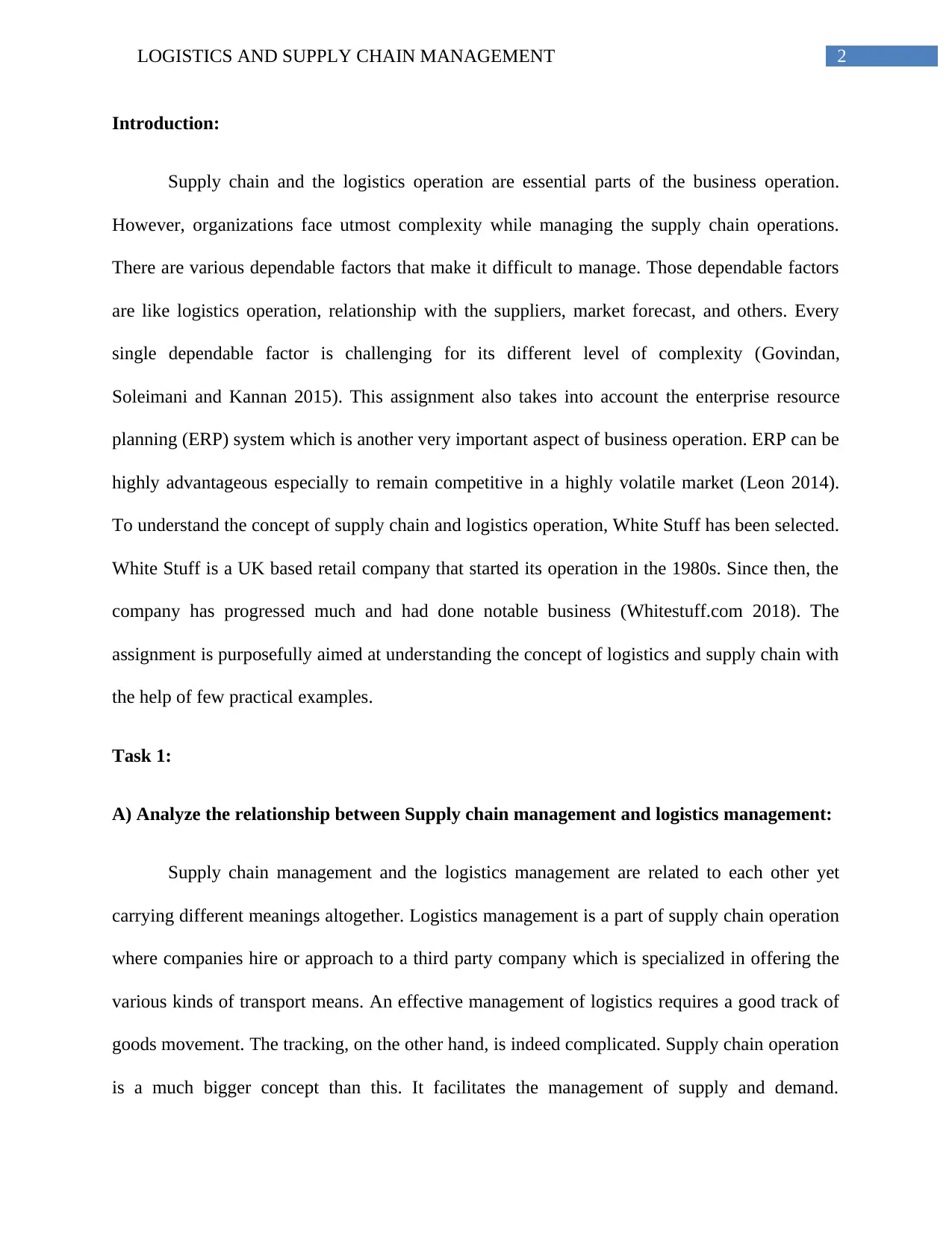
2LOGISTICS AND SUPPLY CHAIN MANAGEMENT
Introduction:
Supply chain and the logistics operation are essential parts of the business operation.
However, organizations face utmost complexity while managing the supply chain operations.
There are various dependable factors that make it difficult to manage. Those dependable factors
are like logistics operation, relationship with the suppliers, market forecast, and others. Every
single dependable factor is challenging for its different level of complexity (Govindan,
Soleimani and Kannan 2015). This assignment also takes into account the enterprise resource
planning (ERP) system which is another very important aspect of business operation. ERP can be
highly advantageous especially to remain competitive in a highly volatile market (Leon 2014).
To understand the concept of supply chain and logistics operation, White Stuff has been selected.
White Stuff is a UK based retail company that started its operation in the 1980s. Since then, the
company has progressed much and had done notable business (Whitestuff.com 2018). The
assignment is purposefully aimed at understanding the concept of logistics and supply chain with
the help of few practical examples.
Task 1:
A) Analyze the relationship between Supply chain management and logistics management:
Supply chain management and the logistics management are related to each other yet
carrying different meanings altogether. Logistics management is a part of supply chain operation
where companies hire or approach to a third party company which is specialized in offering the
various kinds of transport means. An effective management of logistics requires a good track of
goods movement. The tracking, on the other hand, is indeed complicated. Supply chain operation
is a much bigger concept than this. It facilitates the management of supply and demand.
Introduction:
Supply chain and the logistics operation are essential parts of the business operation.
However, organizations face utmost complexity while managing the supply chain operations.
There are various dependable factors that make it difficult to manage. Those dependable factors
are like logistics operation, relationship with the suppliers, market forecast, and others. Every
single dependable factor is challenging for its different level of complexity (Govindan,
Soleimani and Kannan 2015). This assignment also takes into account the enterprise resource
planning (ERP) system which is another very important aspect of business operation. ERP can be
highly advantageous especially to remain competitive in a highly volatile market (Leon 2014).
To understand the concept of supply chain and logistics operation, White Stuff has been selected.
White Stuff is a UK based retail company that started its operation in the 1980s. Since then, the
company has progressed much and had done notable business (Whitestuff.com 2018). The
assignment is purposefully aimed at understanding the concept of logistics and supply chain with
the help of few practical examples.
Task 1:
A) Analyze the relationship between Supply chain management and logistics management:
Supply chain management and the logistics management are related to each other yet
carrying different meanings altogether. Logistics management is a part of supply chain operation
where companies hire or approach to a third party company which is specialized in offering the
various kinds of transport means. An effective management of logistics requires a good track of
goods movement. The tracking, on the other hand, is indeed complicated. Supply chain operation
is a much bigger concept than this. It facilitates the management of supply and demand.
⊘ This is a preview!⊘
Do you want full access?
Subscribe today to unlock all pages.

Trusted by 1+ million students worldwide

3LOGISTICS AND SUPPLY CHAIN MANAGEMENT
Moreover, it involves not only the flow of goods but also keeps a track of market forecast,
relationship with suppliers, service providers, and distributors (Brandenburg et al. 2014).
Logistics are hired for receiving raw materials from suppliers. It is also being hired to
outflow the manufactured goods to the distribution center and then to the market (Alftan et al.
2015). An effective supply chain operation can help to improve the market forecasting capability
which is necessary to avoid material wastage. This may also help organizations to become cost-
effective. Supply chain operation is also responsible to build up a good relationship with
suppliers which are necessary to reduce the bargaining power of suppliers and also to enhance
the reception of quality materials (Alftan et al. 2015).
The main concept of the supply chain is to maintain a healthy flow of goods from
manufacturers to end-users. A healthy flow of goods means a lot like timely delivery of goods in
market, effective relationship with suppliers, good control on logistics operation. When these
things are combined with few technologies, it produces an effective movement of goods in the
supply chain. Those few technologies may include but are not limited to like Just in Time (JIT),
Efficient Customer Response (ECR), and Electronic Data Interchange (EDI) (Chin, Tat and
Sulaiman 2015).
B) As an entrepreneur or a logistics manager, assess the significance of an effective logistics
management function in achieving customer satisfaction.
The logistics operation is responsible for receiving materials and to deliver it to the
customer-end. The process looks much simpler; however, the operation is much more critical. It
is critical as in most cases organizations especially the small and medium size (SMEs)
companies depend on third party service providers for the operation. An effective logistics
Moreover, it involves not only the flow of goods but also keeps a track of market forecast,
relationship with suppliers, service providers, and distributors (Brandenburg et al. 2014).
Logistics are hired for receiving raw materials from suppliers. It is also being hired to
outflow the manufactured goods to the distribution center and then to the market (Alftan et al.
2015). An effective supply chain operation can help to improve the market forecasting capability
which is necessary to avoid material wastage. This may also help organizations to become cost-
effective. Supply chain operation is also responsible to build up a good relationship with
suppliers which are necessary to reduce the bargaining power of suppliers and also to enhance
the reception of quality materials (Alftan et al. 2015).
The main concept of the supply chain is to maintain a healthy flow of goods from
manufacturers to end-users. A healthy flow of goods means a lot like timely delivery of goods in
market, effective relationship with suppliers, good control on logistics operation. When these
things are combined with few technologies, it produces an effective movement of goods in the
supply chain. Those few technologies may include but are not limited to like Just in Time (JIT),
Efficient Customer Response (ECR), and Electronic Data Interchange (EDI) (Chin, Tat and
Sulaiman 2015).
B) As an entrepreneur or a logistics manager, assess the significance of an effective logistics
management function in achieving customer satisfaction.
The logistics operation is responsible for receiving materials and to deliver it to the
customer-end. The process looks much simpler; however, the operation is much more critical. It
is critical as in most cases organizations especially the small and medium size (SMEs)
companies depend on third party service providers for the operation. An effective logistics
Paraphrase This Document
Need a fresh take? Get an instant paraphrase of this document with our AI Paraphraser
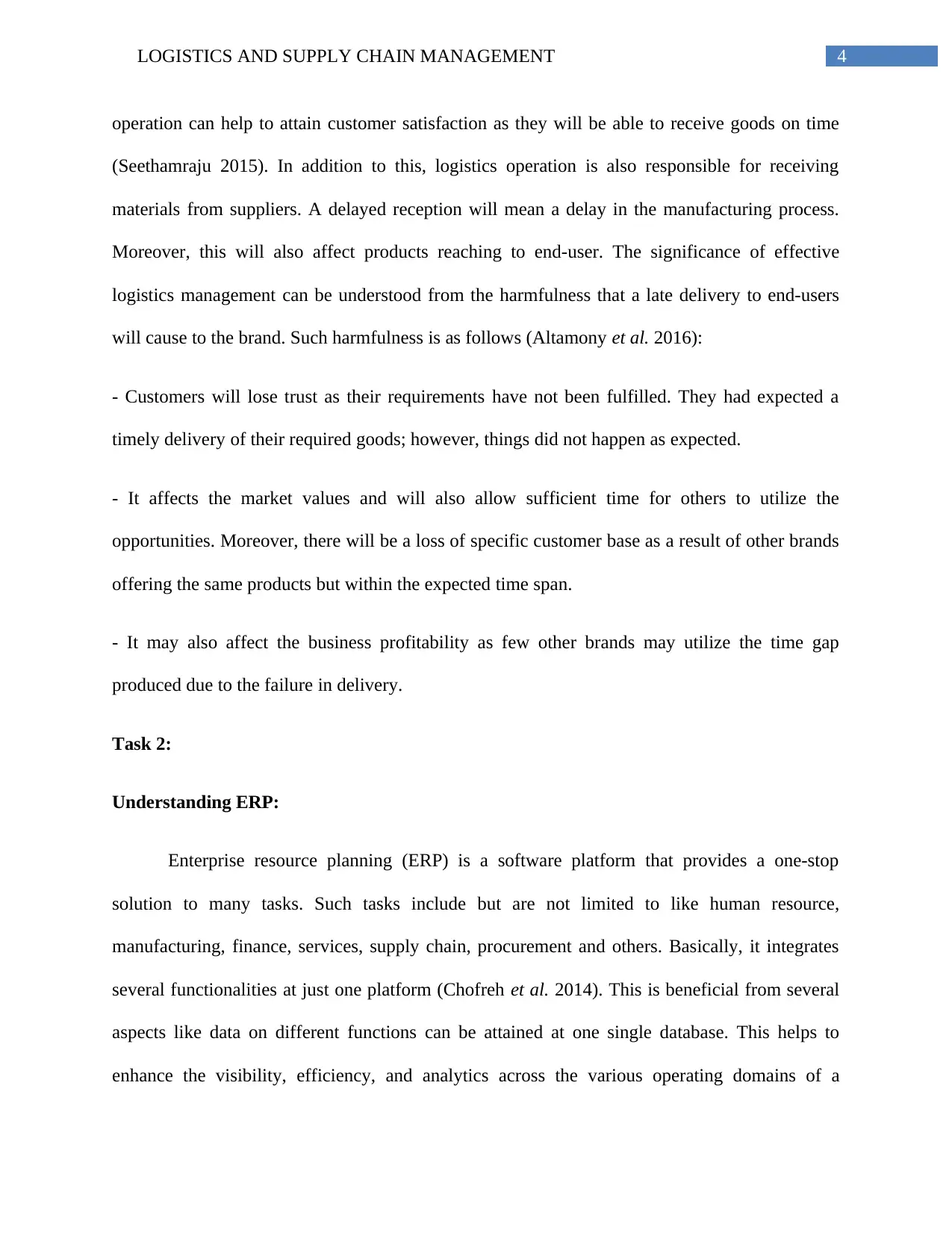
4LOGISTICS AND SUPPLY CHAIN MANAGEMENT
operation can help to attain customer satisfaction as they will be able to receive goods on time
(Seethamraju 2015). In addition to this, logistics operation is also responsible for receiving
materials from suppliers. A delayed reception will mean a delay in the manufacturing process.
Moreover, this will also affect products reaching to end-user. The significance of effective
logistics management can be understood from the harmfulness that a late delivery to end-users
will cause to the brand. Such harmfulness is as follows (Altamony et al. 2016):
- Customers will lose trust as their requirements have not been fulfilled. They had expected a
timely delivery of their required goods; however, things did not happen as expected.
- It affects the market values and will also allow sufficient time for others to utilize the
opportunities. Moreover, there will be a loss of specific customer base as a result of other brands
offering the same products but within the expected time span.
- It may also affect the business profitability as few other brands may utilize the time gap
produced due to the failure in delivery.
Task 2:
Understanding ERP:
Enterprise resource planning (ERP) is a software platform that provides a one-stop
solution to many tasks. Such tasks include but are not limited to like human resource,
manufacturing, finance, services, supply chain, procurement and others. Basically, it integrates
several functionalities at just one platform (Chofreh et al. 2014). This is beneficial from several
aspects like data on different functions can be attained at one single database. This helps to
enhance the visibility, efficiency, and analytics across the various operating domains of a
operation can help to attain customer satisfaction as they will be able to receive goods on time
(Seethamraju 2015). In addition to this, logistics operation is also responsible for receiving
materials from suppliers. A delayed reception will mean a delay in the manufacturing process.
Moreover, this will also affect products reaching to end-user. The significance of effective
logistics management can be understood from the harmfulness that a late delivery to end-users
will cause to the brand. Such harmfulness is as follows (Altamony et al. 2016):
- Customers will lose trust as their requirements have not been fulfilled. They had expected a
timely delivery of their required goods; however, things did not happen as expected.
- It affects the market values and will also allow sufficient time for others to utilize the
opportunities. Moreover, there will be a loss of specific customer base as a result of other brands
offering the same products but within the expected time span.
- It may also affect the business profitability as few other brands may utilize the time gap
produced due to the failure in delivery.
Task 2:
Understanding ERP:
Enterprise resource planning (ERP) is a software platform that provides a one-stop
solution to many tasks. Such tasks include but are not limited to like human resource,
manufacturing, finance, services, supply chain, procurement and others. Basically, it integrates
several functionalities at just one platform (Chofreh et al. 2014). This is beneficial from several
aspects like data on different functions can be attained at one single database. This helps to
enhance the visibility, efficiency, and analytics across the various operating domains of a
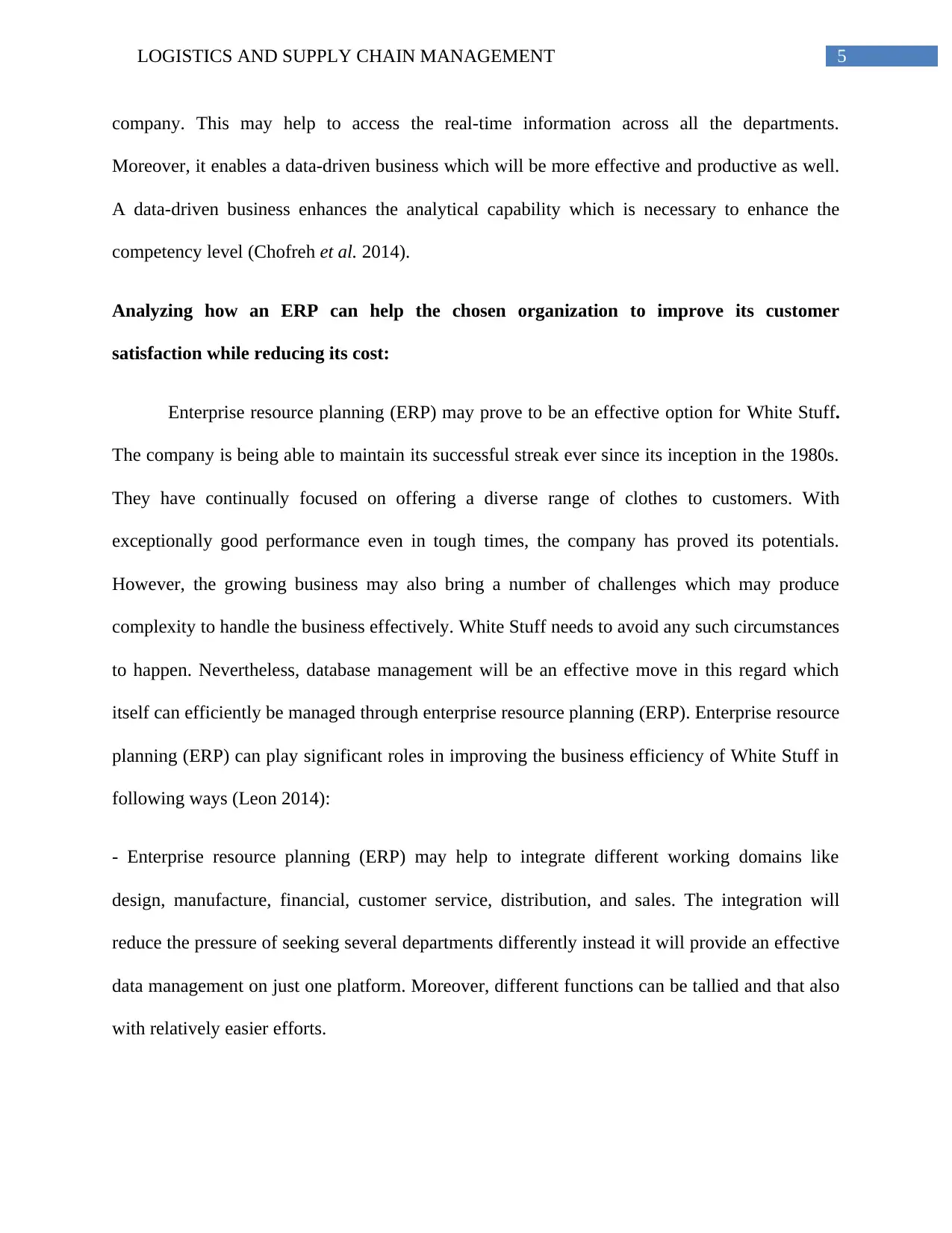
5LOGISTICS AND SUPPLY CHAIN MANAGEMENT
company. This may help to access the real-time information across all the departments.
Moreover, it enables a data-driven business which will be more effective and productive as well.
A data-driven business enhances the analytical capability which is necessary to enhance the
competency level (Chofreh et al. 2014).
Analyzing how an ERP can help the chosen organization to improve its customer
satisfaction while reducing its cost:
Enterprise resource planning (ERP) may prove to be an effective option for White Stuff.
The company is being able to maintain its successful streak ever since its inception in the 1980s.
They have continually focused on offering a diverse range of clothes to customers. With
exceptionally good performance even in tough times, the company has proved its potentials.
However, the growing business may also bring a number of challenges which may produce
complexity to handle the business effectively. White Stuff needs to avoid any such circumstances
to happen. Nevertheless, database management will be an effective move in this regard which
itself can efficiently be managed through enterprise resource planning (ERP). Enterprise resource
planning (ERP) can play significant roles in improving the business efficiency of White Stuff in
following ways (Leon 2014):
- Enterprise resource planning (ERP) may help to integrate different working domains like
design, manufacture, financial, customer service, distribution, and sales. The integration will
reduce the pressure of seeking several departments differently instead it will provide an effective
data management on just one platform. Moreover, different functions can be tallied and that also
with relatively easier efforts.
company. This may help to access the real-time information across all the departments.
Moreover, it enables a data-driven business which will be more effective and productive as well.
A data-driven business enhances the analytical capability which is necessary to enhance the
competency level (Chofreh et al. 2014).
Analyzing how an ERP can help the chosen organization to improve its customer
satisfaction while reducing its cost:
Enterprise resource planning (ERP) may prove to be an effective option for White Stuff.
The company is being able to maintain its successful streak ever since its inception in the 1980s.
They have continually focused on offering a diverse range of clothes to customers. With
exceptionally good performance even in tough times, the company has proved its potentials.
However, the growing business may also bring a number of challenges which may produce
complexity to handle the business effectively. White Stuff needs to avoid any such circumstances
to happen. Nevertheless, database management will be an effective move in this regard which
itself can efficiently be managed through enterprise resource planning (ERP). Enterprise resource
planning (ERP) can play significant roles in improving the business efficiency of White Stuff in
following ways (Leon 2014):
- Enterprise resource planning (ERP) may help to integrate different working domains like
design, manufacture, financial, customer service, distribution, and sales. The integration will
reduce the pressure of seeking several departments differently instead it will provide an effective
data management on just one platform. Moreover, different functions can be tallied and that also
with relatively easier efforts.
⊘ This is a preview!⊘
Do you want full access?
Subscribe today to unlock all pages.

Trusted by 1+ million students worldwide

6LOGISTICS AND SUPPLY CHAIN MANAGEMENT
- ERP may also be fruitful for White Stuff in regards to meeting the different requirements like
lower prices of products, better quality of goods and real-time delivery of goods.
- ERP helps to access the actual database enabling one to get the correct set of data without any
flaw. Moreover, data management will improve and hence, the decision-making of the case
company will also get better.
- It is secured and also provides a quick & reliable access to a set of data. ERP can prove to be a
real time-saving factor for White Stuff.
- ERP will also help to standardize the process of manufacturing. Moreover, the case
organization will be able to get a standardized version of manufacturing for different techniques.
Hence, this will improve the service quality.
- ERP also helps to improve the business process flow which is good for improving the
fulfillment process. This may also effectively reduce the inventory loads and hence, will reduce
the overall operational cost.
- By providing real-time tracking of inventories, it allows users to have a widened view of
forecasts. Moreover, White Stuff will be able to have an enhanced view on forecasts. The
accuracy will be attained through real-time information and facts. This is much more advanced
and useful as well than just creating educated guesses.
- Importantly, it also provides education on seasonal demand shifts. Additionally, it also provides
information on order patterns, lost sales, stock-out dates, others pattern and excess orders. These
all can be analyzed in real-time and provide an enhanced control to the management of case
study organization.
- ERP may also be fruitful for White Stuff in regards to meeting the different requirements like
lower prices of products, better quality of goods and real-time delivery of goods.
- ERP helps to access the actual database enabling one to get the correct set of data without any
flaw. Moreover, data management will improve and hence, the decision-making of the case
company will also get better.
- It is secured and also provides a quick & reliable access to a set of data. ERP can prove to be a
real time-saving factor for White Stuff.
- ERP will also help to standardize the process of manufacturing. Moreover, the case
organization will be able to get a standardized version of manufacturing for different techniques.
Hence, this will improve the service quality.
- ERP also helps to improve the business process flow which is good for improving the
fulfillment process. This may also effectively reduce the inventory loads and hence, will reduce
the overall operational cost.
- By providing real-time tracking of inventories, it allows users to have a widened view of
forecasts. Moreover, White Stuff will be able to have an enhanced view on forecasts. The
accuracy will be attained through real-time information and facts. This is much more advanced
and useful as well than just creating educated guesses.
- Importantly, it also provides education on seasonal demand shifts. Additionally, it also provides
information on order patterns, lost sales, stock-out dates, others pattern and excess orders. These
all can be analyzed in real-time and provide an enhanced control to the management of case
study organization.
Paraphrase This Document
Need a fresh take? Get an instant paraphrase of this document with our AI Paraphraser
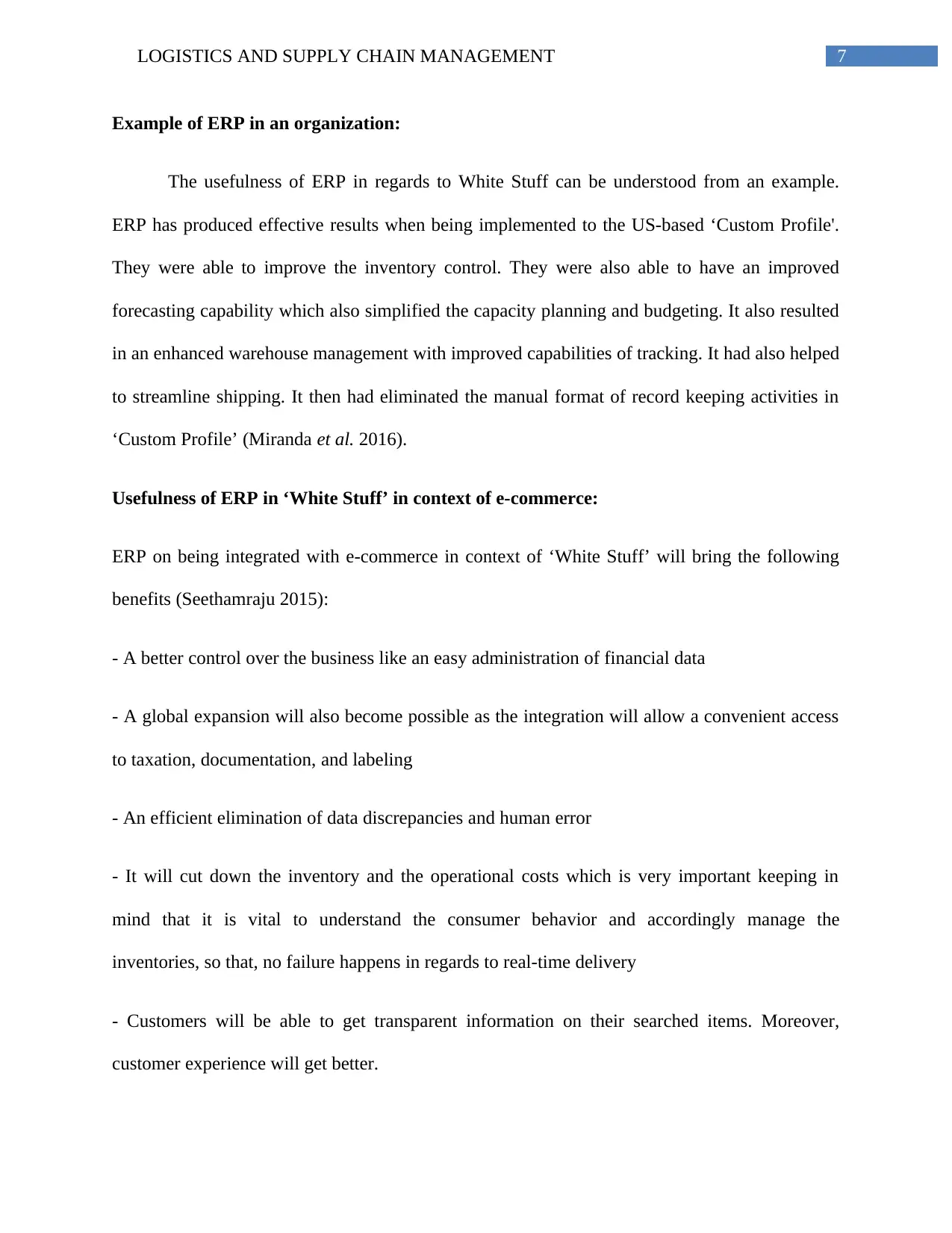
7LOGISTICS AND SUPPLY CHAIN MANAGEMENT
Example of ERP in an organization:
The usefulness of ERP in regards to White Stuff can be understood from an example.
ERP has produced effective results when being implemented to the US-based ‘Custom Profile'.
They were able to improve the inventory control. They were also able to have an improved
forecasting capability which also simplified the capacity planning and budgeting. It also resulted
in an enhanced warehouse management with improved capabilities of tracking. It had also helped
to streamline shipping. It then had eliminated the manual format of record keeping activities in
‘Custom Profile’ (Miranda et al. 2016).
Usefulness of ERP in ‘White Stuff’ in context of e-commerce:
ERP on being integrated with e-commerce in context of ‘White Stuff’ will bring the following
benefits (Seethamraju 2015):
- A better control over the business like an easy administration of financial data
- A global expansion will also become possible as the integration will allow a convenient access
to taxation, documentation, and labeling
- An efficient elimination of data discrepancies and human error
- It will cut down the inventory and the operational costs which is very important keeping in
mind that it is vital to understand the consumer behavior and accordingly manage the
inventories, so that, no failure happens in regards to real-time delivery
- Customers will be able to get transparent information on their searched items. Moreover,
customer experience will get better.
Example of ERP in an organization:
The usefulness of ERP in regards to White Stuff can be understood from an example.
ERP has produced effective results when being implemented to the US-based ‘Custom Profile'.
They were able to improve the inventory control. They were also able to have an improved
forecasting capability which also simplified the capacity planning and budgeting. It also resulted
in an enhanced warehouse management with improved capabilities of tracking. It had also helped
to streamline shipping. It then had eliminated the manual format of record keeping activities in
‘Custom Profile’ (Miranda et al. 2016).
Usefulness of ERP in ‘White Stuff’ in context of e-commerce:
ERP on being integrated with e-commerce in context of ‘White Stuff’ will bring the following
benefits (Seethamraju 2015):
- A better control over the business like an easy administration of financial data
- A global expansion will also become possible as the integration will allow a convenient access
to taxation, documentation, and labeling
- An efficient elimination of data discrepancies and human error
- It will cut down the inventory and the operational costs which is very important keeping in
mind that it is vital to understand the consumer behavior and accordingly manage the
inventories, so that, no failure happens in regards to real-time delivery
- Customers will be able to get transparent information on their searched items. Moreover,
customer experience will get better.
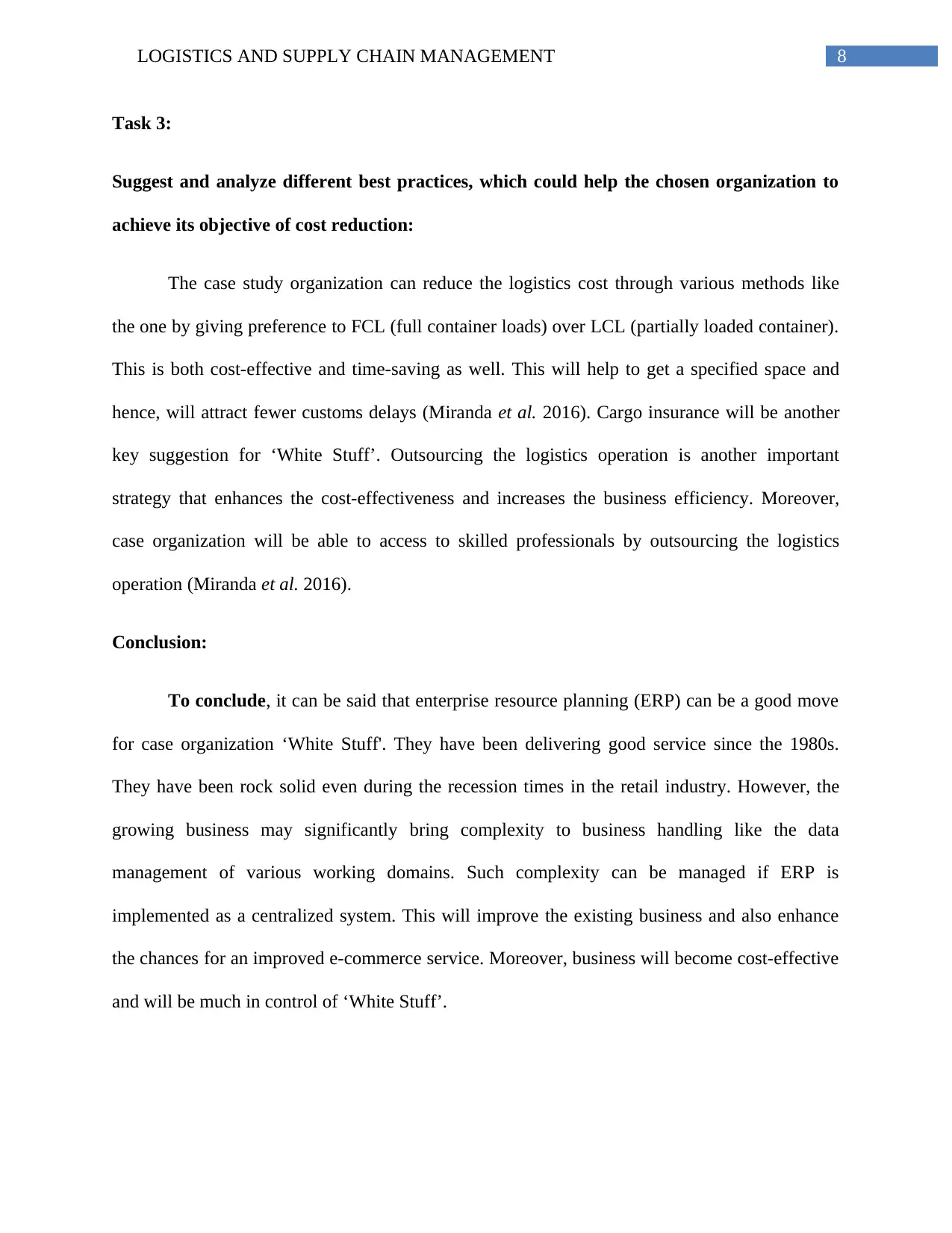
8LOGISTICS AND SUPPLY CHAIN MANAGEMENT
Task 3:
Suggest and analyze different best practices, which could help the chosen organization to
achieve its objective of cost reduction:
The case study organization can reduce the logistics cost through various methods like
the one by giving preference to FCL (full container loads) over LCL (partially loaded container).
This is both cost-effective and time-saving as well. This will help to get a specified space and
hence, will attract fewer customs delays (Miranda et al. 2016). Cargo insurance will be another
key suggestion for ‘White Stuff’. Outsourcing the logistics operation is another important
strategy that enhances the cost-effectiveness and increases the business efficiency. Moreover,
case organization will be able to access to skilled professionals by outsourcing the logistics
operation (Miranda et al. 2016).
Conclusion:
To conclude, it can be said that enterprise resource planning (ERP) can be a good move
for case organization ‘White Stuff'. They have been delivering good service since the 1980s.
They have been rock solid even during the recession times in the retail industry. However, the
growing business may significantly bring complexity to business handling like the data
management of various working domains. Such complexity can be managed if ERP is
implemented as a centralized system. This will improve the existing business and also enhance
the chances for an improved e-commerce service. Moreover, business will become cost-effective
and will be much in control of ‘White Stuff’.
Task 3:
Suggest and analyze different best practices, which could help the chosen organization to
achieve its objective of cost reduction:
The case study organization can reduce the logistics cost through various methods like
the one by giving preference to FCL (full container loads) over LCL (partially loaded container).
This is both cost-effective and time-saving as well. This will help to get a specified space and
hence, will attract fewer customs delays (Miranda et al. 2016). Cargo insurance will be another
key suggestion for ‘White Stuff’. Outsourcing the logistics operation is another important
strategy that enhances the cost-effectiveness and increases the business efficiency. Moreover,
case organization will be able to access to skilled professionals by outsourcing the logistics
operation (Miranda et al. 2016).
Conclusion:
To conclude, it can be said that enterprise resource planning (ERP) can be a good move
for case organization ‘White Stuff'. They have been delivering good service since the 1980s.
They have been rock solid even during the recession times in the retail industry. However, the
growing business may significantly bring complexity to business handling like the data
management of various working domains. Such complexity can be managed if ERP is
implemented as a centralized system. This will improve the existing business and also enhance
the chances for an improved e-commerce service. Moreover, business will become cost-effective
and will be much in control of ‘White Stuff’.
⊘ This is a preview!⊘
Do you want full access?
Subscribe today to unlock all pages.

Trusted by 1+ million students worldwide
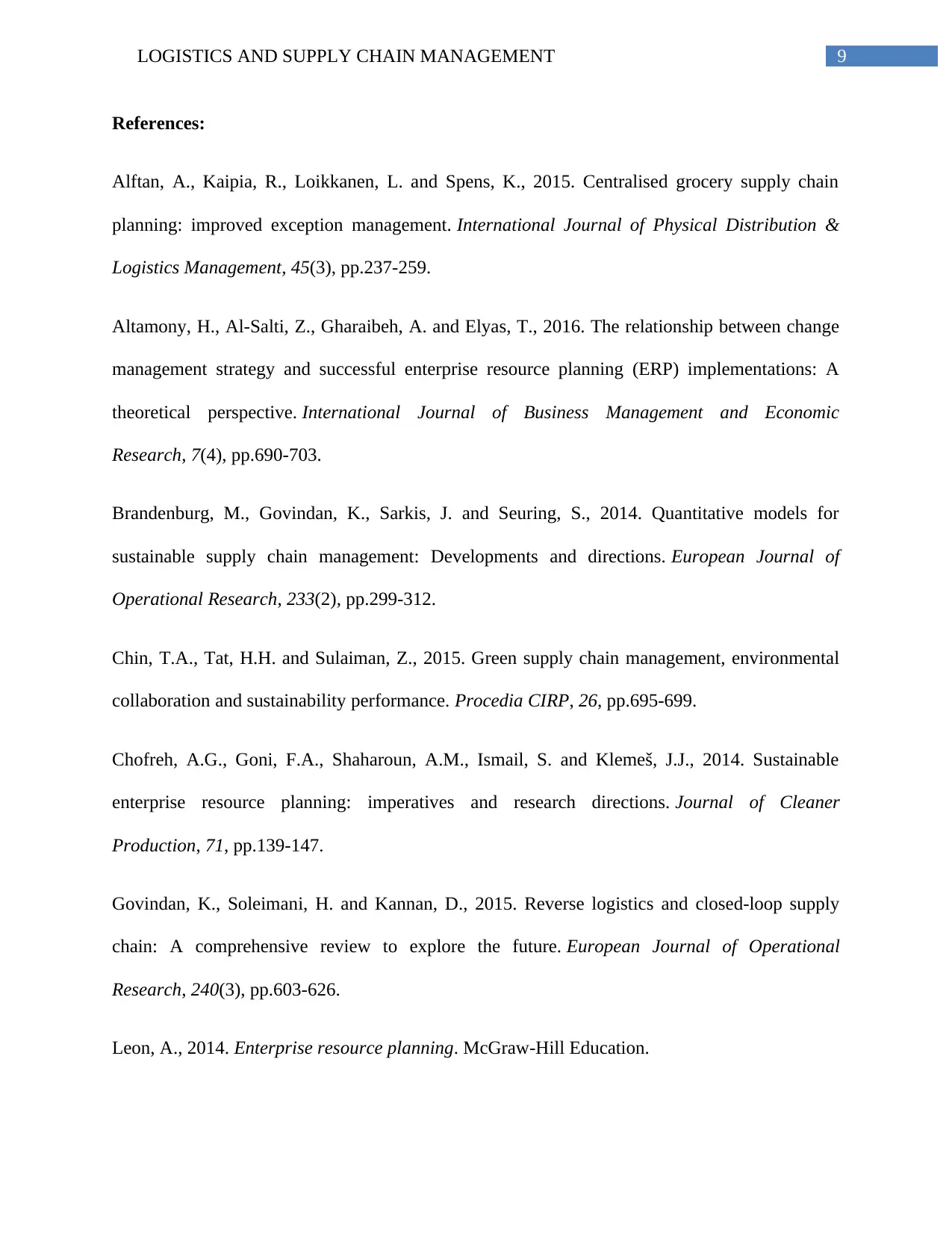
9LOGISTICS AND SUPPLY CHAIN MANAGEMENT
References:
Alftan, A., Kaipia, R., Loikkanen, L. and Spens, K., 2015. Centralised grocery supply chain
planning: improved exception management. International Journal of Physical Distribution &
Logistics Management, 45(3), pp.237-259.
Altamony, H., Al-Salti, Z., Gharaibeh, A. and Elyas, T., 2016. The relationship between change
management strategy and successful enterprise resource planning (ERP) implementations: A
theoretical perspective. International Journal of Business Management and Economic
Research, 7(4), pp.690-703.
Brandenburg, M., Govindan, K., Sarkis, J. and Seuring, S., 2014. Quantitative models for
sustainable supply chain management: Developments and directions. European Journal of
Operational Research, 233(2), pp.299-312.
Chin, T.A., Tat, H.H. and Sulaiman, Z., 2015. Green supply chain management, environmental
collaboration and sustainability performance. Procedia CIRP, 26, pp.695-699.
Chofreh, A.G., Goni, F.A., Shaharoun, A.M., Ismail, S. and Klemeš, J.J., 2014. Sustainable
enterprise resource planning: imperatives and research directions. Journal of Cleaner
Production, 71, pp.139-147.
Govindan, K., Soleimani, H. and Kannan, D., 2015. Reverse logistics and closed-loop supply
chain: A comprehensive review to explore the future. European Journal of Operational
Research, 240(3), pp.603-626.
Leon, A., 2014. Enterprise resource planning. McGraw-Hill Education.
References:
Alftan, A., Kaipia, R., Loikkanen, L. and Spens, K., 2015. Centralised grocery supply chain
planning: improved exception management. International Journal of Physical Distribution &
Logistics Management, 45(3), pp.237-259.
Altamony, H., Al-Salti, Z., Gharaibeh, A. and Elyas, T., 2016. The relationship between change
management strategy and successful enterprise resource planning (ERP) implementations: A
theoretical perspective. International Journal of Business Management and Economic
Research, 7(4), pp.690-703.
Brandenburg, M., Govindan, K., Sarkis, J. and Seuring, S., 2014. Quantitative models for
sustainable supply chain management: Developments and directions. European Journal of
Operational Research, 233(2), pp.299-312.
Chin, T.A., Tat, H.H. and Sulaiman, Z., 2015. Green supply chain management, environmental
collaboration and sustainability performance. Procedia CIRP, 26, pp.695-699.
Chofreh, A.G., Goni, F.A., Shaharoun, A.M., Ismail, S. and Klemeš, J.J., 2014. Sustainable
enterprise resource planning: imperatives and research directions. Journal of Cleaner
Production, 71, pp.139-147.
Govindan, K., Soleimani, H. and Kannan, D., 2015. Reverse logistics and closed-loop supply
chain: A comprehensive review to explore the future. European Journal of Operational
Research, 240(3), pp.603-626.
Leon, A., 2014. Enterprise resource planning. McGraw-Hill Education.
Paraphrase This Document
Need a fresh take? Get an instant paraphrase of this document with our AI Paraphraser
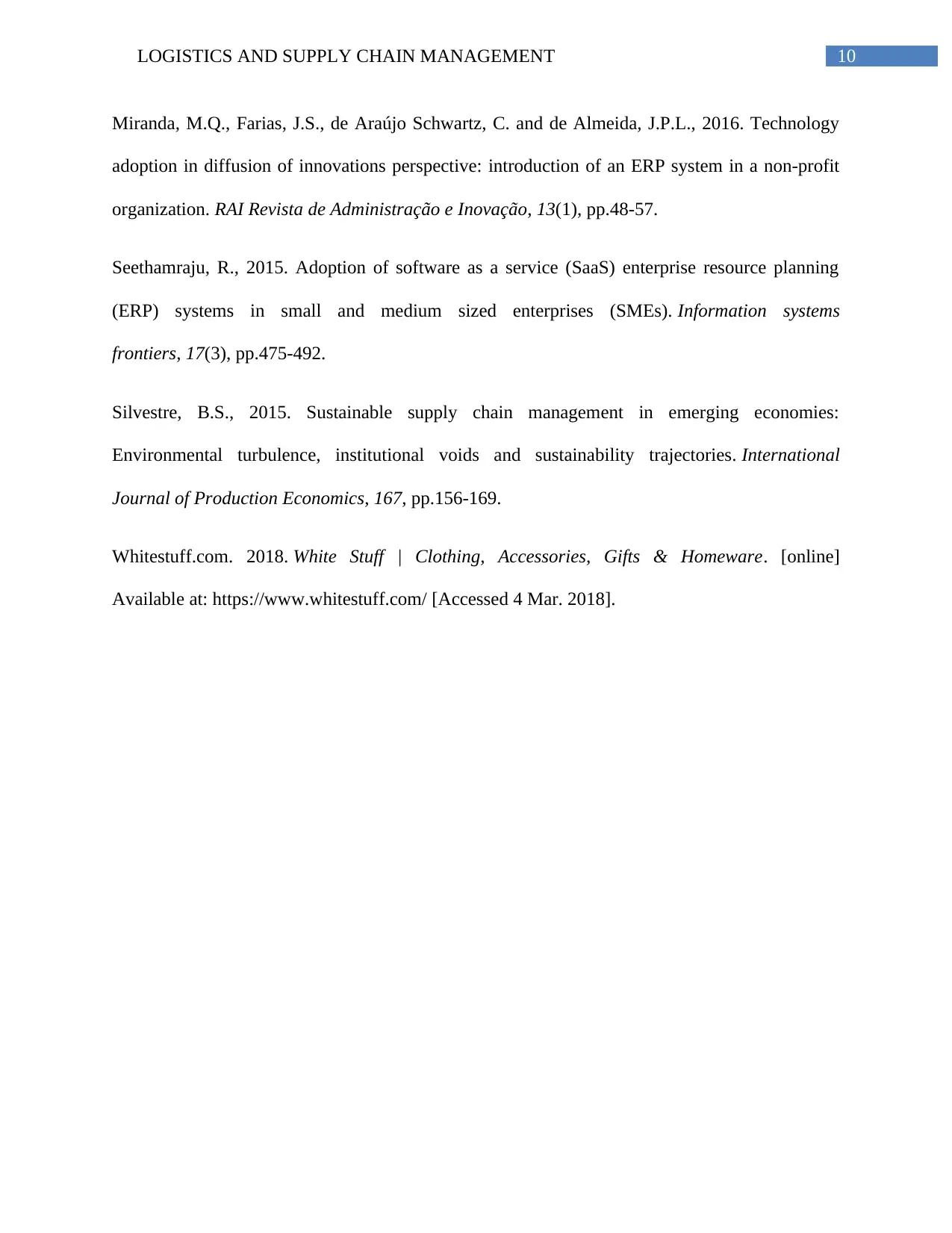
10LOGISTICS AND SUPPLY CHAIN MANAGEMENT
Miranda, M.Q., Farias, J.S., de Araújo Schwartz, C. and de Almeida, J.P.L., 2016. Technology
adoption in diffusion of innovations perspective: introduction of an ERP system in a non-profit
organization. RAI Revista de Administração e Inovação, 13(1), pp.48-57.
Seethamraju, R., 2015. Adoption of software as a service (SaaS) enterprise resource planning
(ERP) systems in small and medium sized enterprises (SMEs). Information systems
frontiers, 17(3), pp.475-492.
Silvestre, B.S., 2015. Sustainable supply chain management in emerging economies:
Environmental turbulence, institutional voids and sustainability trajectories. International
Journal of Production Economics, 167, pp.156-169.
Whitestuff.com. 2018. White Stuff | Clothing, Accessories, Gifts & Homeware. [online]
Available at: https://www.whitestuff.com/ [Accessed 4 Mar. 2018].
Miranda, M.Q., Farias, J.S., de Araújo Schwartz, C. and de Almeida, J.P.L., 2016. Technology
adoption in diffusion of innovations perspective: introduction of an ERP system in a non-profit
organization. RAI Revista de Administração e Inovação, 13(1), pp.48-57.
Seethamraju, R., 2015. Adoption of software as a service (SaaS) enterprise resource planning
(ERP) systems in small and medium sized enterprises (SMEs). Information systems
frontiers, 17(3), pp.475-492.
Silvestre, B.S., 2015. Sustainable supply chain management in emerging economies:
Environmental turbulence, institutional voids and sustainability trajectories. International
Journal of Production Economics, 167, pp.156-169.
Whitestuff.com. 2018. White Stuff | Clothing, Accessories, Gifts & Homeware. [online]
Available at: https://www.whitestuff.com/ [Accessed 4 Mar. 2018].
1 out of 11
Related Documents
Your All-in-One AI-Powered Toolkit for Academic Success.
+13062052269
info@desklib.com
Available 24*7 on WhatsApp / Email
![[object Object]](/_next/static/media/star-bottom.7253800d.svg)
Unlock your academic potential
Copyright © 2020–2025 A2Z Services. All Rights Reserved. Developed and managed by ZUCOL.




